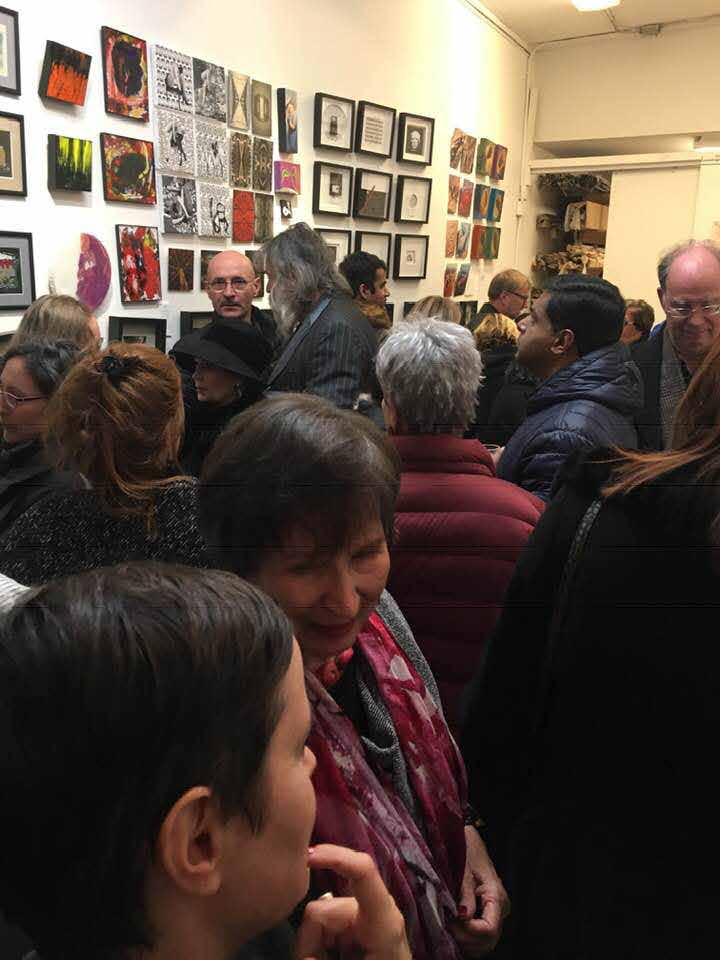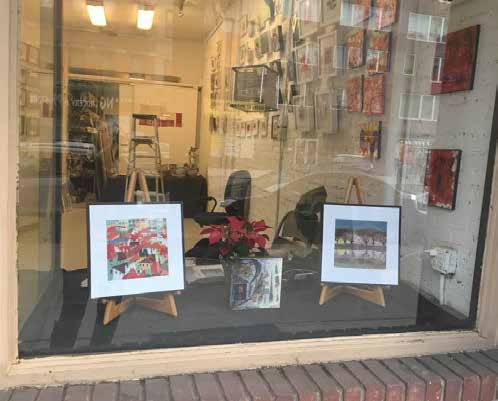In a well-known parable, many of us understand that the tiny mustard seed grows to spiritual greatness. From this aphorism, we learn majesty can arise from the smallest object. So too, in the works recently seen in “Small is Great” at Jadite Gallery on Tenth Avenue in New York City, 23 artists demonstrate their talents in an inspired outing, with pieces, that although diminutive in size, convey a boundless creativity and beauty. Curated by Basha Maryanska, who also participates in the exhibit, the gallery is filled with paintings, photographs, collages, prints and fiber creations expertly realized to warm the beginnings of winter.
Virginia Donovan makes serious statements in small acrylic squares, her layering and scraping of color a salute to the flags of America and Poland in a palette of reds, blues and whites. In one painting, black striations cut the canvas perpendicularly against deep indigo-purple, thus creating simultaneous balance and tension across the picture plane with bursts of energy pulsating within boundaries of formidable spatial economy.
Jadwiga Iwanska’s petite fiber collages pay homage to the countryside of Tuscany along with sewn landscapes. She creates urban reddened rooftops in one picture, the elements geometric and bright, contrasting that with a sensitive fall turning to winter scene where trees reflect in lacey arrangements, portending the short bleak days ahead. She conveys a broad range of emotions through expertly stitched forms.
In eight small mixed media hanging sculptures, the series entitled “Amalgam,” Kathryn Hart confronts the viewer with constructed pieces made from handmade paper impregnated with twine and employing other various elements, among them, ink, found objects and resin, all incorporated in organic forms, generating tactile whole entities. Hart’s signature style underscores her on-going search for life’s meaning through diverse themes, which seem to coalesce allowing the viewer to experience a range of deep feelings.
Annie Vallamattam has really expanded her horizons under Basha Maryanska’s tutelage, in this exhibit producing dynamic abstract acrylic canvases where the pigments swirl across the surfaces. The young artist explores what it means to make art, documenting the creative impulse, taking pure pleasure in the creative impulse.
Basha Maryanska foregoes big brushstrokes on large canvases for smaller monoprints of saturated primary colors, the artist’s gestural manipulations of paint blending splotches of dancing color in mesmerizing whirlwinds, the resulting prints alluding to galactic energies. The artist contrasts these bold pieces with a serene painted collage of muted colors depicting her impressions of a modern city.

Chris Neyen’s small photographs are only so in their physicality as he loads these pieces with psychological import, the abstract images being mirror-like. He digitally deforms photos of industrial spaces where machinery and textile mills become bold geometrics.
Jeffrey Anzevino’s magnificent aerial photographs of Navajo country employ his expertise in cartography and geography to capture the reservation landscape. Through use of a Nikon digital camera and the creation of aluminum prints, he celebrates wind and water sculpting of this western land and brings the viewer a poetic understanding of the natural place, so sacred to native peoples of America.
You Ye Chu is an expressionist painter trained in Shanghai who has exhibited in Asia, Europe and the United States. Her piece, “Autumn Trees,” in bright warm colors, is lyrically painted with dynamic brushwork and the entire work sings chromatic songs.
Ania Gilmore’s works on paper use the Joomchi traditional felting technique where the handmade paper, through the artist’s manipulation of media, morphs into lush red and pristine white forms to drape the gallery wall. Gilmore teaches this sculpting method, with its philosophy involving impermanence and has exhibited her pieces at the Hangaram Art Museum in Korea, the technique’s country of origin, along with other places throughout the world.
Hui Laurine’s tape paintings are startling in that the canvases in their entireties depict the frontal nudity of a woman’s body with phrases about what it means to love a man, attached to the surfaces of the canvases, taped at jagged angles, the words slashing the painterly flesh. The artist feels that a woman loses her identity in the act of loving and sees it poetically as a wound that the taped words on the painted grounds cover –but not completely– so the pain from the surrender to love is always hauntingly present.
We enter a child’s sweet world in Bojana Leznicka’s fiber collages of a penguin, rocks, a fence and a lovely blue sky. All elements of an environment of simple wonder, these pieces are meditations on Leznicka’s process and craft. Besides working as an accomplished artist, she is a master teacher of tapestry. She has taught at The School of Visual Arts and the Newark Museum, in addition to acting as a professional conservator. Krystyna Malinowska states that she believes in transgressive activities and the pictures in this exhibit are exemplars of this by making political statements about perceptions of femininity. Here, she deforms the female body by bunching together disembodied women’s legs in all types of disjointed positions, juxtaposing them with ornamental, patterned backgrounds. The legs become aggressive, fetishized as hostile projectiles on the decorative underlying repetitive surfaces. These pieces could be interpreted as the artist’s statement that women are not seductive toys to be trivialized as sex objects, but instead should be celebrated as full embodiments of the divine feminine with its natural grace and beauty.
Juanita Oosthuizen, of South Africa, creates tiny black and white worlds by placing miniature playful figurines and pictures in box frames. The artist provides humorous commentary on modern life with subjects such as a crenulated photo of Picasso, and a representation of banking as a somewhat unworthy endeavor that was particularly enjoyable. The satirical microcosms Oosthuizen makes of our human condition provide timely social value.
Joanna Owidzka is a textile artist who weaves poetically. Her small works in this exhibit are fiber sketches of minute observations of her environment, where she concentrates on individual elements of her world, the results being charming pictures in harmonious arrangements that bring happiness to her viewing audience.
New England based artist, Janet Parker, honors nature in her serene paintings of birds’ nests. They were originally done to soothe her feelings about her daughter’s leaving for college and seeing a group of them in this gallery space brings a sense of natural beauty and comfort to this viewer.
The pieces by Neela Pushparaj take a turn different from her glorious floral renderings, demonstrating another delightful aspect to her prodigious talents. She painted detailed watercolor studies of butterflies in her garden and exquisite specimens, such as the Southern Bud Wing and Buddha’s Peacock, as they gently alight on sensitive blooms. These tiny regal jewels emanate from this artist’s powers of observation and love of nature.
Cynthia McCusker, a certified New York State Art Teacher, adds to her important role as educator by becoming a great champion of the environment, painting these small works —using a strong saturated palette— to celebrate the earth’s mysterious creative forces. She shows relationships of animals and plants to humanity in kaleidoscopic whirls of colors, combined with semi-realistic subjects, compelling the viewer to respect our planet’s awe-inspiring generative powers.

The understated, elegant abstract acrylic, gouache and ink paintings on linen canvases by Anne Plaisance embody strong underlying emotions contained in economies of space. Her pieces might seem superficially calm in their somewhat minimalist compositions, but are contrasted by the artist’s expressive title choices and applications of warm reds, deep roses, and cool blues amid curving golds, in entangled pipe forms. They subliminally remind this viewer of sensuous entwining limbs.
Arlene Seymour-Robin is newly arrived at abstraction and her work here, of strong gestural brights, grasps a full range of feelings in new dizzying hot vibrant orange expressions. This painter is unafraid to wrestle her creative energies to the picture plane bringing her feelings front and center, thus giving the small pieces a sense of expansive drama.
Kamila Wojciechowicz-Krauze is an accomplished illustrator currently working on a children’s book. In this exhibit, mythic miniatures of cherubs, angels and beasts skip lightly or strut powerfully in the small spaced frames, with colors gleaming from the surfaces of Hahnemuehle German etching paper. I find hypnotic her sepia-toned print “Nauki, Forest Nymphs,” where the fairies of the dark woods evoke mysterious teachers.
Along with her studies for her sublime costumes, Eva Lachur is also an accomplished painter showing a very observant piece about winter. Her stark depiction of a bare tree, in the throes of a snowstorm’s brutal winds, is contrasted with a happy study of a proud perky rooster announcing sunrise in bright morning colors.
Ilona Wojciechowska exhibits atmospheric semi-abstract images of the city at different times of day and night. She sensitively paints this environment in rich shades of purple, blue and green –with the shadows cast among the buildings becoming strong geometrics that at the same time hold ethereal qualities because of the color choices. The artist makes magical lines and spaces on the canvases where painted elements harmonize and contrast with each other.
Keeping his observant lens open to the frenetic movements of cars, people, buildings and lights, Mietko Rudek’s manipulations of city scenes, through the technique he calls “photo/graphy,” transform the real documentation of the metropolitan landscape into dramatic abstract visions of constant motion. Through digital alchemy, Rudek creates an alternate world where urban images of fast-paced living become almost tangible.
The miniscule mustard seed becomes a giant tree where magnitude of form and spirit come from an unlikely and what is perceived as an inconsequential source. Jadite Gallery, 660 Tenth Avenue, in Manhattan, is a small space in a huge city. Its sturdy brick walls hold works that are only physically slight. This little gem of a venue provides strong support for an art exhibit of inspiration and splendor and I’m glad I had the opportunity to see it. —Anne Rudder





Leave a Comment